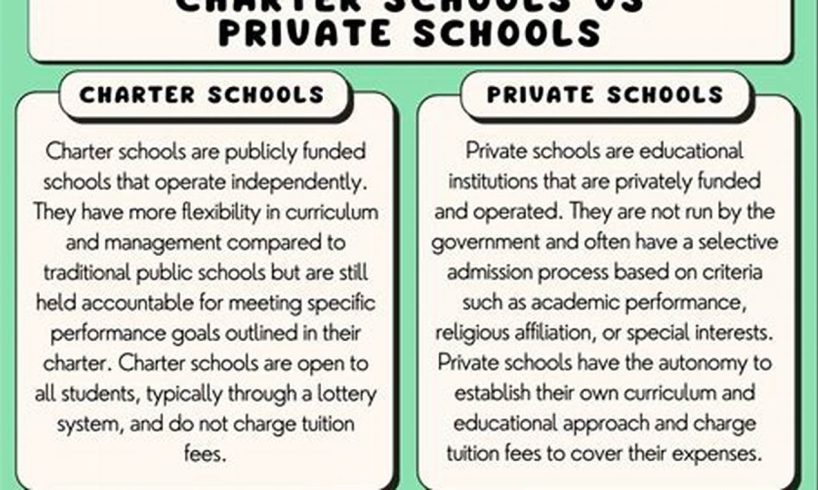
Charter schools are publicly funded schools that are independently operated. They are not considered private schools, as they are not subject to the same regulations and do not charge tuition. However, charter schools have more flexibility than traditional public schools in terms of curriculum and instruction.
Charter schools were first created in the 1990s as a way to improve public education. They have since become increasingly popular, and there are now over 7,000 charter schools in the United States. Charter schools have been shown to have a number of benefits over traditional public schools, including higher student achievement, improved graduation rates, and increased parental satisfaction.
Charter schools are often compared to private schools because they offer more choice and flexibility than traditional public schools. However, charter schools are not private schools, and they are not subject to the same regulations. Charter schools are also typically funded at a lower level than private schools.
1. Publicly funded
The fact that charter schools are publicly funded is a key distinction between charter schools and private schools. Private schools are funded through tuition payments from parents, while charter schools receive funding from the government. This means that charter schools are free to attend, just like traditional public schools.
The public funding that charter schools receive gives them a number of advantages over private schools. First, it allows charter schools to offer a free education to all students, regardless of their family’s income. Second, it gives charter schools access to a wider range of resources, such as state and federal grants. Third, it gives charter schools the stability and support they need to plan for the long term.
Of course, there are also some challenges that come with being publicly funded. For example, charter schools are subject to the same regulations as traditional public schools. This means that they must follow the same curriculum and testing requirements. Additionally, charter schools are often funded at a lower level than traditional public schools. This can make it difficult for charter schools to compete for resources, such as teachers and supplies.
Overall, the fact that charter schools are publicly funded is a key distinction between charter schools and private schools. It gives charter schools a number of advantages, but it also comes with some challenges.
2. Independently operated
The fact that charter schools are independently operated is a key distinction between charter schools and private schools. Private schools are typically subject to the same regulations as traditional public schools, while charter schools have more flexibility in terms of curriculum and instruction.
This flexibility allows charter schools to meet the needs of a diverse range of students. For example, some charter schools focus on providing a rigorous academic education, while others focus on providing a more hands-on, project-based learning experience. Additionally, charter schools can offer specialized programs, such as programs for students with special needs or programs for students who are interested in a particular field of study.
The flexibility that charter schools have in terms of curriculum and instruction is one of the main reasons why they are so popular. Parents and students are increasingly looking for schools that can meet their individual needs, and charter schools are able to provide that.
However, it is important to note that the flexibility that charter schools have also comes with some challenges. For example, charter schools are not subject to the same accountability standards as traditional public schools. This means that charter schools can be more difficult to hold accountable for their performance.
Overall, the fact that charter schools are independently operated is a key distinction between charter schools and private schools. It gives charter schools more flexibility in terms of curriculum and instruction, which allows them to meet the needs of a diverse range of students.
3. Do not charge tuition
The fact that charter schools do not charge tuition is a key distinction between charter schools and private schools. Private schools typically charge tuition, while charter schools are free to attend. This makes charter schools more accessible to families of all income levels.
The fact that charter schools are free to attend is one of the main reasons why they are so popular. Parents and students are increasingly looking for schools that are affordable and provide a quality education. Charter schools are able to provide both of these things.
In addition to being free to attend, charter schools also offer a number of other advantages over private schools. For example, charter schools are typically more flexible in terms of curriculum and instruction. This allows charter schools to meet the needs of a diverse range of students. Additionally, charter schools are often more innovative than private schools. They are willing to try new things and experiment with new approaches to education.
Overall, the fact that charter schools do not charge tuition is a key distinction between charter schools and private schools. It makes charter schools more accessible to families of all income levels and gives charter schools a number of advantages over private schools.
4. More flexibility
The flexibility that charter schools have in terms of curriculum and instruction is one of the key differences between charter schools and traditional public schools. This flexibility allows charter schools to meet the needs of a diverse range of students and to offer specialized programs that may not be available in traditional public schools.
For example, some charter schools focus on providing a rigorous academic education, while others focus on providing a more hands-on, project-based learning experience. Additionally, charter schools can offer specialized programs, such as programs for students with special needs or programs for students who are interested in a particular field of study.
The flexibility that charter schools have in terms of curriculum and instruction is one of the main reasons why they are so popular. Parents and students are increasingly looking for schools that can meet their individual needs, and charter schools are able to provide that.
However, it is important to note that the flexibility that charter schools have also comes with some challenges. For example, charter schools are not subject to the same accountability standards as traditional public schools. This means that charter schools can be more difficult to hold accountable for their performance.
Overall, the flexibility that charter schools have in terms of curriculum and instruction is a key distinction between charter schools and traditional public schools. It gives charter schools more flexibility to meet the needs of a diverse range of students, but it also comes with some challenges.
5. Not subject to the same regulations
One of the key differences between charter schools and traditional public schools is that charter schools are not subject to the same regulations. This gives charter schools more flexibility in terms of curriculum, instruction, and operations. For example, charter schools can set their own hours, adopt their own curriculum, and hire their own teachers. This flexibility allows charter schools to meet the needs of a diverse range of students and to offer specialized programs that may not be available in traditional public schools.
The flexibility that charter schools have is a key factor in their ability to provide a high-quality education to students. For example, a charter school that focuses on STEM education can offer a more rigorous curriculum in math and science than a traditional public school. Additionally, a charter school that serves a high population of students with special needs can offer specialized programs and services that are not available in traditional public schools.
However, it is important to note that the flexibility that charter schools have also comes with some challenges. For example, charter schools are not subject to the same accountability standards as traditional public schools. This means that charter schools can be more difficult to hold accountable for their performance. Additionally, charter schools are often funded at a lower level than traditional public schools. This can make it difficult for charter schools to compete for resources, such as teachers and supplies.
Overall, the fact that charter schools are not subject to the same regulations as traditional public schools is a key factor in their ability to provide a high-quality education to students. However, it is important to be aware of the challenges that charter schools face as a result of their flexibility.
6. Different funding levels
The funding of charter schools is a key factor in understanding their relationship to private schools. Charter schools are typically funded at a lower level than private schools, which has a number of implications.
- Lower per-pupil spending
Charter schools typically receive less funding per pupil than private schools. This is because charter schools are funded by the government, while private schools are funded by tuition payments from parents. As a result, charter schools have to be more efficient with their spending than private schools.
- Limited access to resources
The lower funding levels of charter schools can limit their access to resources, such as teachers, supplies, and facilities. This can make it difficult for charter schools to provide the same level of education as private schools.
- Increased reliance on fundraising
Charter schools often have to rely on fundraising to supplement their government funding. This can be a time-consuming and challenging process. Additionally, it can lead to charter schools being beholden to donors, which can compromise their independence.
- Challenges in attracting and retaining high-quality teachers
The lower funding levels of charter schools can make it difficult to attract and retain high-quality teachers. This is because teachers in charter schools are typically paid less than teachers in private schools. Additionally, charter schools often have less flexibility in terms of teacher benefits, such as health insurance and retirement plans.
The different funding levels between charter schools and private schools is a key factor in understanding their relationship. The lower funding levels of charter schools can limit their access to resources, make it difficult to attract and retain high-quality teachers, and increase their reliance on fundraising. As a result, charter schools may not be able to provide the same level of education as private schools.
Frequently Asked Questions about Charter Schools and Private Schools
This section addresses common questions and misconceptions regarding the relationship between charter schools and private schools.
Question 1: Are charter schools considered private schools?
Answer: No, charter schools are not considered private schools. They are publicly funded schools that are independently operated. This means that they are not subject to the same regulations as traditional public schools and have more flexibility in terms of curriculum and instruction. However, charter schools are also not considered private schools because they do not charge tuition.
Question 2: Are charter schools better than private schools?
Answer: There is no one-size-fits-all answer to this question. The best school for a particular child depends on their individual needs and preferences. However, charter schools have been shown to have a number of advantages over traditional public schools, including higher student achievement, improved graduation rates, and increased parental satisfaction.
Question 3: Are charter schools more expensive than private schools?
Answer: No, charter schools are not more expensive than private schools. In fact, charter schools are free to attend, just like traditional public schools. Private schools, on the other hand, typically charge tuition. The amount of tuition charged varies depending on the school.
Question 4: Are charter schools more selective than private schools?
Answer: It depends. Some charter schools are more selective than others, and some private schools are more selective than others. However, in general, charter schools are not more selective than private schools. In fact, many charter schools have open enrollment policies, which means that any student who meets the age requirements can attend.
Question 5: Are charter schools safer than private schools?
Answer: There is no evidence to suggest that charter schools are safer or more dangerous than private schools. The safety of a school depends on a number of factors, such as the school’s location, the school’s security measures, and the school’s culture.
Question 6: What are the main differences between charter schools and private schools?
Answer: The main differences between charter schools and private schools are that charter schools are publicly funded and do not charge tuition, while private schools are privately funded and typically charge tuition. Additionally, charter schools have more flexibility in terms of curriculum and instruction than traditional public schools, while private schools have even more flexibility.
Summary: Charter schools and private schools are both unique types of schools that offer a number of advantages over traditional public schools. The best school for a particular child depends on their individual needs and preferences.
Transition: The next section of this article will discuss the history of charter schools.
Tips for Choosing Between Charter Schools and Private Schools
Choosing the right school for your child is a big decision. If you’re considering a charter school or a private school, it’s important to do your research and understand the key differences between the two types of schools.
Tip 1: Consider your child’s individual needs.
Every child is different, so it’s important to consider your child’s individual needs when choosing a school. Charter schools and private schools offer different advantages, so it’s important to find a school that is a good fit for your child’s learning style and personality.
Tip 2: Visit the schools you’re considering.
The best way to get a feel for a school is to visit it in person. This will give you a chance to see the school’s facilities, meet the teachers and staff, and talk to current students and parents. Visiting the schools will also give you a sense of the school’s culture and whether it is a good fit for your child.
Tip 3: Compare the schools’ academic programs.
Charter schools and private schools offer a variety of academic programs, so it’s important to compare the programs of the schools you’re considering. Consider your child’s interests and strengths, and make sure that the school’s academic program is a good fit for your child’s needs.
Tip 4: Consider the schools’ extracurricular activities.
Extracurricular activities can play an important role in your child’s development. Charter schools and private schools offer a variety of extracurricular activities, so it’s important to compare the activities offered by the schools you’re considering. Make sure that the school offers activities that your child is interested in and that fit your child’s schedule.
Tip 5: Consider the schools’ costs.
The cost of a school is an important factor to consider. Charter schools are free to attend, while private schools typically charge tuition. The amount of tuition charged varies depending on the school. It’s important to factor in the cost of tuition when making your decision.
Tip 6: Consider the schools’ locations.
The location of a school is an important factor to consider. Charter schools and private schools are located in a variety of areas, so it’s important to choose a school that is convenient for you and your child.
Tip 7: Trust your instincts.
After you’ve considered all of the factors, it’s important to trust your instincts. Choose the school that you feel is the best fit for your child. Remember, the best school for one child may not be the best school for another child.
Conclusion:
Choosing the right school for your child is a big decision. By following these tips, you can make an informed decision that is in the best interests of your child.
Conclusion
Charter schools and private schools are both unique types of schools that offer a number of advantages over traditional public schools. Charter schools are publicly funded and do not charge tuition, while private schools are privately funded and typically charge tuition. Additionally, charter schools have more flexibility in terms of curriculum and instruction than traditional public schools, while private schools have even more flexibility.
The best school for a particular child depends on their individual needs and preferences. However, it is important to remember that charter schools are not private schools. Charter schools are publicly funded and are subject to the same regulations as traditional public schools. Additionally, charter schools are not always more selective than private schools. In fact, many charter schools have open enrollment policies, which means that any student who meets the age requirements can attend.
If you are considering a charter school or a private school for your child, it is important to do your research and understand the key differences between the two types of schools. By considering your child’s individual needs, visiting the schools you’re considering, and comparing the schools’ academic programs, extracurricular activities, costs, and locations, you can make an informed decision that is in the best interests of your child.






